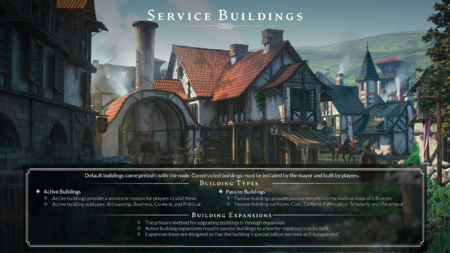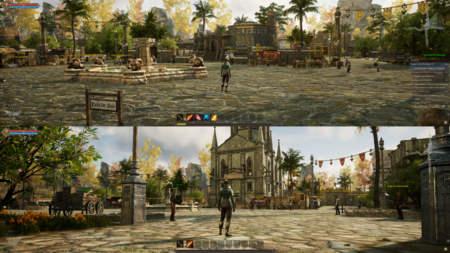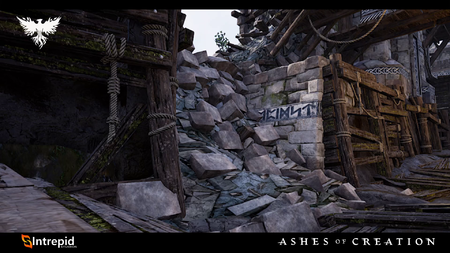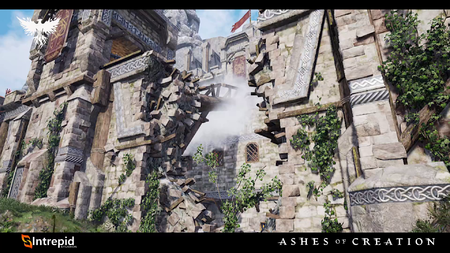Node footprint
A node's footprint is the development area where the node's buildings are located.[1]
Node buildings

The important thing with the service building system for us is that it's a way to shape your node like a character; and to give you an exclusive niche that you can carve out in the world; or a niche that you fight over. If you go down this weaponsmithing path and you build your node to be this mecca of weaponsmithing and the node three doors down builds it, there's reason for you to conflict over it. They're taking your business. Or maybe you are in a zone and there isn't a weaponsmithing thing anywhere near you, and you do want to start to carve that path for yourself to make your node a place people visit and come to.[3] – Chris Justo
Service buildings within a node are either default buildings that come with the node, or they are constructed buildings, which are initiated by the mayor and built by players.[2][3][4][5][6][7][8] Service buildings are further broken down into two main types:[2][3]
- Active service buildings are service buildings that players directly interact with. These are further broken down into Artisanship, Business, Content, and Political categories.[2][3]
- Passive service buildings provide passive benefits to the node or its zone of influence. These buildings are broken down into Civic, Cultural, Fabrication, Scholarly, and Vocational.[2][3]
- Constructed service buildings are available to every type of node in every location. Where the uniqueness comes in is in some of the default buildings like your node-type building.[9] – Chris Justo
Service buildings are upgraded by expansions, which are unlocked through the placement of passive service buildings.[2][3]
- Building expansions unlock higher tier workstations at the cost of dedicating service building plots.[10][6]
- Node service building expansions specialize the building through a tech tree based on the stage of the node.[11][12]
Service buildings incur a regular maintenance cost of node commodities and gold from the node treasury in order to continue operations.[2][13]
Node development

The layout and architecture within a Node’s development area are determined by influential race. For example, a stage 3 Node with the majority of player contribution being Py'rai would have a Py'rai village with Py'rai architecture. Most NPCs would be Py'rai elves, and offer questlines within the Py'rai narrative.[14] – Margaret Krohn
Each player’s contributed experience is flagged with their character race and other identifiers. When a Node advances, the race with the highest experience contribution determines the Node’s style and culture. This style and culture change can happen at every Node Stage. For example, if a Node advances to Level 2 - Encampment Stage and 51% of all experience was earned by Ren’Kai players, the Node will be a Level 2 Ren’Kai Node. If that same Node advances to a Level 3 - Village Stage Node, but the Py'Rai contributed 62% of all the experience earned, then the Node will be a Level 3 Py'Rai Node.[15] – Margaret Krohn
Node layout and style is determined by several factors:[16][17]
- The way that the node system is built is that they can exist across a spread of 18 biomes, but at the same time have to represent the cultural influence of these cultures that are intrinsically a part of a specific biome.[18] – Steven Sharif
- Environment (biome) and location of the node.[18][16][17]
- Nodes will adjust the local topography to fit the aesthetic and mechanical requirements of the node.[19]
- Currently the way that the platform system is set up, is it's capable of adjusting the topography of the node's footprint, regardless of the surrounding terrain. So the reason for that is we want to have flexibility in the presentation of the node's layout and how it is essentially both from an aesthetic standpoint as well as a mechanical standpoint with node sieges- how it's constructed and that construction should have the ability to take on a variance of different types of topography. So it shouldn't be dependent on the surrounding area. Now that's not to say that the surrounding area isn't going to have some influence over. So for example... we're experimenting a little bit with the platform tech and putting up a node up against the side of a mountain or on the edge of a cliff or something that has a beautiful vista. Those are things that we're going to test out obviously as we continue to work on the node tool and how that platform system works, but the idea is to have the node independent of the surrounding terrain.[19] – Steven Sharif
- Some parts are determined by the area it's in. Some parts are determined by the type it is. Some parts are determined by the race it is; and then the rest of it is determined by the mayor.[17] – Jeffrey Bard
- Race that contributed the highest percentage to the node's advancement will alter the racial appearance of its buildings, NPCs, and props.[20][21][16][15][17][22][23]
- All nodes, whether they're associated with a castle or associated with normal node structure, has cultural influences that replicate over to the buildings that are produced and the NPCs that are present.[25] – Steven Sharif
- The rest is determined by the node's mayor.[17]
- It should be possible for a node to complete several building projects within a mayor's one month term in office.[26]
- Q: How long would you say it will take players on average to fill/build up a node completely from wilderness to metropolis?
- A: It's one thing to get a node to a certain level: it's another thing to develop the node; and I can't really give you an on-average expectation, because there's a lot of variables at play. There's how many citizens does the node have attracted to it; what's the type of traffic that the node is attracting to it based on things like its tax rates, or the specialization that it chose to spec into, based on the building types it's chosen to build. All of those things are variables that can affect the quote-unquote "average build-out time" of a particular node. So it's difficult to give you an average when there's so many variables along those lines. But the idea is that if there is a particular project that players are interested in in developing based on the node stage, that they would have the ability to complete several of those projects as within a single term of a mayor; and a term of a mayor is one month.[26] – Steven Sharif
Node destruction

Nodes can be destroyed starting at Level 3 - Village Stage, and are destroyed through sieges. Sieges are started via an item which is acquired through a quest that scales in difficulty with respect to the level of the Node which is being targeted for the siege. Once the item is brought to the Node and is activated, the declaration period begins and a countdown is initiated for players in the region to see. This countdown runs for a number of days equal to the level of the Node being sieged. Once the countdown is complete, the siege begins. There is a cooldown between sieges, and players must wait a certain amount of time after an unsuccessful siege before a new siege can be declared. The higher the Node level, the longer the cooldown between sieges. If a siege is successful, then the Node is brought down to Level 0, and anyone who was a citizen of that Node is no longer a citizen.[15] – Margaret Krohn
Nodes can be destroyed starting at Village (stage 3) following a successful siege against that node.[15]
- It is a normal process of the world to see PvP be a catalyst for change. That is one of the defining elements of our world building approach and being a PvX game is that PvE builds the world and PvP changes the world; and as these nodes get destructed this should be a normal habit that players are accustomed to seeing that landscape changing over time, because it is the breath of renewal that then is allowed as a result of that action.[27] – Steven Sharif
- Players lose their node citizenship after their node is destroyed without entering into a cooldown period.[27][28][15]
- Node destruction may prevent some quests from being completed.[29]
- After a node is destroyed, the footprint of the node will enter a ruined state and will become an open PvP zone for a number of days equal to the node's level. These ruins consist of a debris field of treasures that are lootable by certain players.[30][1][31][32][33][34]
- Which players get to loot the debris field during this period is currently under discussion by the developers.[35] Previously it was stated that any player could loot the debris field.[1] Before that it was stated that only attackers who participated in the siege will have exclusive looting rights.[36]
- Any loot remaining after this period will be open for anyone to loot.[36]
- After a number of days equal to the destroyed node's level, the node will revert back to stage 0 (wilderness) and any modified terrain will revert back to its original state.[1][37][38]
- Those are like open-world battlegrounds that spawn on the footprint of the node after a successful siege. And these are opportunities that previous defenders have to salvage certain materials and/or equipment from the destroyed node, or that attackers have to do the same. And there's interact points that live within that environment that take time in order to interact with, which makes those individuals susceptible to potential ganking or fighting. And you can control those areas; and that exists for some period of time. It's like an open-world arena system.[30] – Steven Sharif
- Treasures in the debris field will take time and tools to uncover.[30][1]
- The warehouse debris will contain a portion of all Materials (crafting components) and Gatherables that were stored in the destroyed node.[1][31][32][33][34]
- The reliquary debris will contain a stockpile of shards of the relics that were stored there.[39][1][31][40][41]
- The town hall debris might contain tax-oriented certificates that were held within the vaults and in the treasury.[31]
- The stables debris might contain mount certificates that can be added to caravans in the future or sold on the auction house.[31]
- Gatherables and crafting materials that were stored in in-node housing and apartment storage chests become lootable. These are not lootable if the node survives the siege- even if the housing buildings are destroyed or damaged during the siege.[32]
Node building destruction

You could be more precision oriented in the decision to attack a city. Let's say it's a rival node that's trying to reach a node stage five or something and you want to disable their ability for the religious system to progress so you target the temple during the attack, or you want to disable their scholars academy from reaching a higher level so that your nodes can; or you want to disable multiple buildings that allow for experience and quests to be undertaken by its citizenship, which prevents them from keeping up in pace of experience gained with your node. These can be more precision oriented and don't have to effectualize an actual takeover of the node.[43] – Steven Sharif
Node buildings (including player housing) have hit points and can be damaged or destroyed by different systems.[12][32]
- NPC-driven events that are a response to story arcs or node atrophy.[12]
- Node sieges and node wars.[12]
- Attackers may not be capable of destroying a node during a siege. Instead they may carry out precision attacks to disable specific service-oriented buildings within the node. These buildings can be targeted with siege weapons and bombs.[43]
- Hazardous events such as tornadoes or hurricanes.[44][12]
- Mayors have the ability to demolish constructed node buildings. This will have a node mandate cost and will require player buy-in via a vote.[2][13]
- Mayors will also have the ability, if they want, to demolish constructed buildings. So if they if they so choose they can destroy a building if they don't think it's needed anymore. But this will have mandate cost and a player buy-in votes. So we want to make sure that [the] mayor can't just go and blow up the whole node if they're trying to grief or something. So this is very important and impactful decision.[2][13] – John Collins
If building maintenance is not paid, or a building is damaged as the result of an event or siege, the building will enter a state of disarray.[2][13] Any NPCs or services offered by that building will not be available until the building is repaired.[5][32]
- Players must contribute materials to repair disarrayed buildings and restore them to an operational state.[2][13][12][32][45]
If a node siege is successful, or if buildings otherwise take significant damage, they are destroyed and appear as rubble on the plot they occupied.[2][13][12]
- Node governments must clear any rubble on plots before any buildings can be reconstructed. Any prerequisites for the building reconstruction must be satisfied beforehand.[12]
- Buildings also live within a prerequisite system. So in order to build down the tech tree of what these buildings provide, as the node grows larger to access stronger building types, you may get a kink in that chain if it's destroyed and you'll have to stand that back up in order to support the service again.[12] – Steven Sharif
- If the node is destroyed by a node siege, the debris field will contain spoils that are lootable by attackers or defenders.[30][1][31][32][33][34]
- Player housing that is destroyed during a node siege can no longer be sold.[46] Furnishing and decorations are retained and can be placed again later.[46][47][48]
See also
References
- ↑ 1.0 1.1 1.2 1.3 1.4 1.5 1.6 1.7 Livestream, October 14, 2022 (52:31).
- ↑ 2.00 2.01 2.02 2.03 2.04 2.05 2.06 2.07 2.08 2.09 2.10 2.11 Blog: Development Update with Village Node.
- ↑ 3.0 3.1 3.2 3.3 3.4 3.5 3.6 Livestream, August 31, 2023 (50:25).
- ↑ Video, August 31, 2023 (2:59).
- ↑ 5.0 5.1 Interview, July 9, 2023 (1:32:45).
- ↑ 6.0 6.1 Livestream, May 19, 2017 (33:57).
- ↑ Livestream, January 20, 2018 (38:17).
- ↑ Livestream, 2018-04-8 (PM) (51:49).
- ↑ Livestream, August 31, 2023 (56:18).
- ↑ Livestream, August 31, 2023 (52:56).
- ↑ Video, August 31, 2023 (34:37).
- ↑ 12.0 12.1 12.2 12.3 12.4 12.5 12.6 12.7 12.8 Livestream, March 31, 2022 (1:13:00).
- ↑ 13.0 13.1 13.2 13.3 13.4 13.5 Livestream, August 31, 2023 (57:23).
- ↑ Blog - Know Your Nodes - The Basics.
- ↑ 15.0 15.1 15.2 15.3 15.4 15.5 Blog - Know Your Nodes - Advance and Destroy.
- ↑ 16.0 16.1 16.2 Livestream, October 30, 2020 (39:17).
- ↑ 17.0 17.1 17.2 17.3 17.4 17.5 Livestream, September 27, 2018 (53:06).
- ↑ 18.0 18.1 Livestream, February 25, 2022 (41:00).
- ↑ 19.0 19.1 Livestream, February 26, 2021 (1:12:18).
- ↑ Livestream, March 31, 2022 (4:57).
- ↑ Podcast, April 11, 2021 (29:47).
- ↑ Interview, May 11, 2018 (54:34).
- ↑ Livestream, May 26, 2017 (21:23).
- ↑ Podcast, April 11, 2021 (23:36).
- ↑ 25.0 25.1 Interview, May 11, 2018 (47:27).
- ↑ 26.0 26.1 Livestream, July 29, 2022 (1:13:09).
- ↑ 27.0 27.1 Livestream, August 31, 2023 (20:54).
- ↑ Interview, July 29, 2020 (17:26).
- ↑ Livestream, February 29, 2024 (53:58).
- ↑ 30.0 30.1 30.2 30.3 Interview, July 9, 2023 (1:36:24).
- ↑ 31.0 31.1 31.2 31.3 31.4 31.5 Podcast, September 29, 2021 (14:21).
- ↑ 32.0 32.1 32.2 32.3 32.4 32.5 32.6 Interview, July 8, 2020 (57:46).
- ↑ 33.0 33.1 33.2 Livestream, April 30, 2020 (1:14:44).
- ↑ 34.0 34.1 34.2

- ↑ Livestream, July 28, 2023 (1:26:16).
- ↑ 36.0 36.1 Podcast, September 29, 2021 (15:46).
- ↑ Livestream, June 26, 2020 (1:48:43).
- ↑

- ↑

- ↑ Podcast, September 29, 2021 (10:49).
- ↑ Interview, July 18, 2020 (56:11).
- ↑ Livestream, October 31, 2019 (36:20).
- ↑ 43.0 43.1 Livestream, November 22, 2019 (16:56).
- ↑ Forums - Livestream Q&A 2022-08-26.
- ↑ Livestream, November 22, 2019 (17:59).
- ↑ 46.0 46.1 Livestream, June 26, 2020 (1:02:12).
- ↑ Livestream, July 18, 2017 (40:14).
- ↑ Livestream, November 17, 2017 (47:10).
